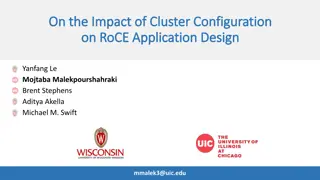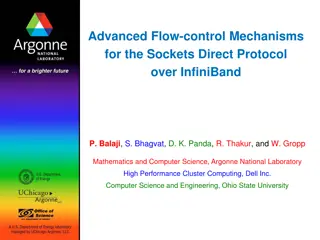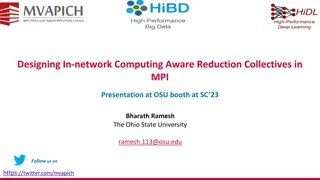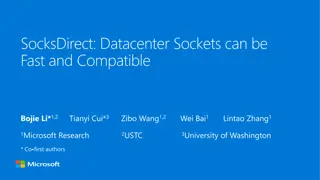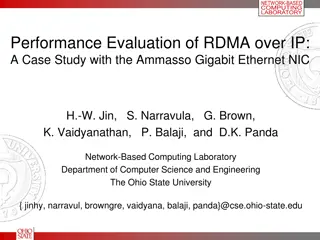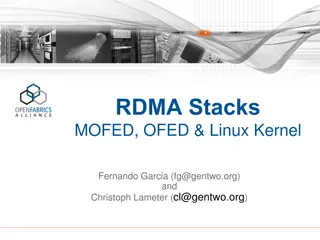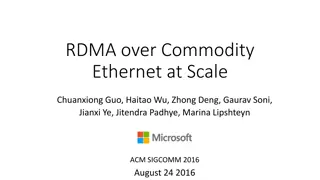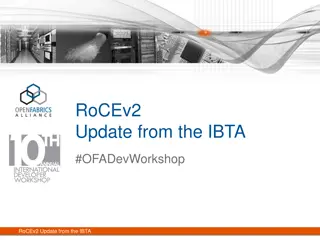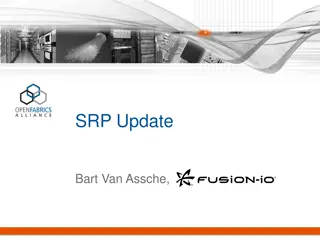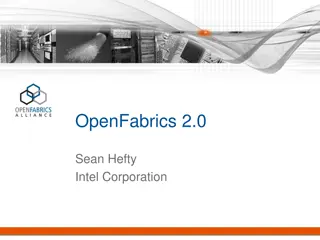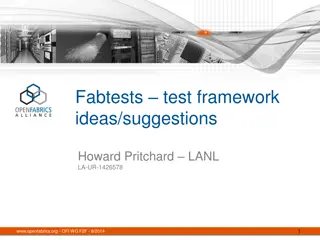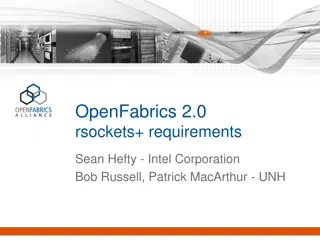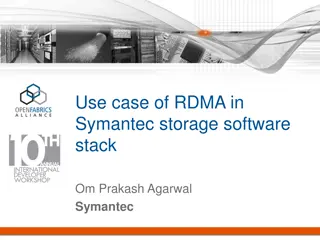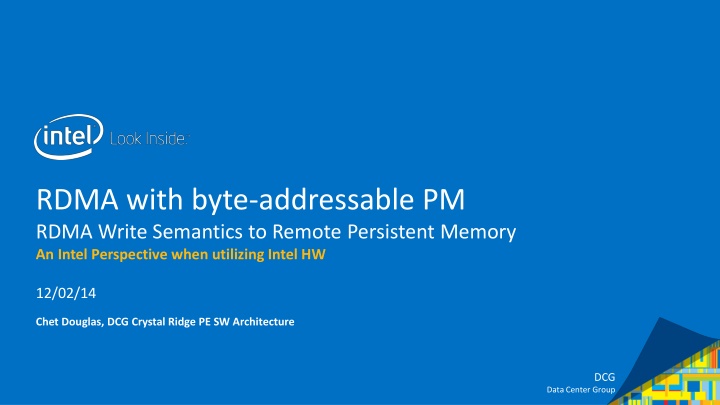
Intel Perspective on RDMA Write Semantics with Byte-Addressable PM Architecture
"Discover the Intel hardware architecture insights regarding RDMA writes to remote persistent memory, including considerations for short-term NVM applications. Learn about ADR domains, DDIO, and enabling non-allocating write transactions. Explore the integration of iMC, CPU, IIO, and more within the architecture framework." (326 characters)
Download Presentation

Please find below an Image/Link to download the presentation.
The content on the website is provided AS IS for your information and personal use only. It may not be sold, licensed, or shared on other websites without obtaining consent from the author. If you encounter any issues during the download, it is possible that the publisher has removed the file from their server.
You are allowed to download the files provided on this website for personal or commercial use, subject to the condition that they are used lawfully. All files are the property of their respective owners.
The content on the website is provided AS IS for your information and personal use only. It may not be sold, licensed, or shared on other websites without obtaining consent from the author.
E N D
Presentation Transcript
RDMA with byte-addressable PM RDMA Write Semantics to Remote Persistent Memory An Intel Perspective when utilizing Intel HW 12/02/14 Chet Douglas, DCG Crystal Ridge PE SW Architecture DCG Data Center Group
RDMA with DRAM Intel HW Architecture ADR Asynchronous DRAM Refresh ADR Domain MAIN Memory Allows DRAM contents to be saved to NVDIMM on power loss ADR Domain All data inside of the domain is protected by ADR and will make it to NVM before supercap power dies. The integrated memory controller is currently inside of the ADR Domain. iMC CPU IIO IIO Integrated IO Controller Internal BUFFERS CORE CORE CORE CORE Controls IO flow between PCIe devices and Main Memory DDIO L L C Allocating Write Transactions Contains internal buffers that are backed by LLC cache. Allocating write transactions from the PCI Root Port will utilize internal buffers backed by LLC core cache. PCI Root Port Data in internal buffers naturally aged out of cache in to main memory RNIC PCI Func PCI Func PCI BM DMA Flow Enable/Disable via BIOS setting per Root PCI Port RNIC RDMA Flow DDIO Data Direct IO PCI Func PCI Func DDIO ON Flow DDIO OFF Flow Allows Bus Mastering PCI & RDMA IO to move data directly in/out of LLC Core Caches Enable/Disable at platform level via BIOS setting DCG Data Center Group 2
RDMA with byte-addressable PM Intel HW Architecture Short Term NVM Considerations ADR Domain With ADR, No DDIO Disable DDIO Requires BIOS Enabling Enable non-allocating Write transactions for Root PCI Port to IIO Requires BIOS Enabling Forces RDMA Write data directly to iMC Enable on PCI Root Port with RNIC Follow RDMA Write(s) with RDMA Read to force remaining IIO buffer write data to ADR Domain Since RDMA Write and Read are silent, there is little or no change to the SW on the node supplying the Sink buffers for RDMA Write NVM iMC CPU IIO Internal BUFFERS CORE CORE CORE CORE DDIO L L C Non-Allocating Write Transactions PCI Root Port RNIC RDMA Write Flow RNIC RNIC RDMA Read Flow RDMA Write Data forced to ADR Domain by RDMA Read Flow Write Data forced to persistence by ADR Flow DCG Data Center Group 3
RDMA with byte-addressable PM Intel HW Architecture Short Term NVM Considerations ADR Domain Without ADR, No DDIO Disable DDIO Requires BIOS Enabling Enable non-allocating Write transactions for Root PCI Port to IIO Requires BIOS Enabling Forces RDMA Write data directly to iMC Enable on PCI Root Port with RNIC Follow RDMA Write(s) with RDMA Read to force remaining IIO buffer write data to ADR Domain Follow RDMA Read with Send/Receive to get callback to force write data in the iMC to become persistent ISA - PCOMMIT/SFENCE Flush iMC and make data persistent NVM iMC CPU IIO Internal BUFFERS CORE CORE CORE CORE DDIO L L C Non-Allocating Write Transactions PCI Root Port RNIC RDMA Write Flow RNIC RNIC RDMA Send/Receive Flow RDMA Write Data forced to iMC by Send/Receive Flow Send/Receive Callback PCOMMIT/SFENCE Flow DCG Data Center Group 4
RDMA with byte-addressable PM Intel HW Architecture Short Term NVM Considerations ADR Domain NVM Without ADR, With DDIO Use standard allocating Write transactions for Root PCI Port to IIO Follow RDMA Write(s) with Send/Receive to get local callback to force write data from CPU Cache in to the iMC and to make write data in the iMC persistent Send/Receive will contain list of cache lines that were written ISA CLFLUSHOPT/SFENCE Flush CPU cache lines and wait for flush to complete (invalidates cache contents). The list of cache lines from the Send message is used to identify the cache lines that need to be flushed. ISA - PCOMMIT/SFENCE Flush iMC and make data persistent Internal IIO buffers will be flushed as part of CLFLUSHOPT allowing allocating writes to be used. iMC CPU IIO Internal BUFFERS CORE CORE CORE CORE DDIO L L C Allocating Write Transactions PCI Root Port RNIC RDMA Write Flow RNIC RNIC RDMA Send/Receive Flow RDMA Write Data forced to iMC by Send/Receive Flow Send/Receive Callback CLFLUSHOPT/SFENCE Flow Send/Receive Callback PCOMMIT/SFENCE Flow DCG Data Center Group 5
RDMA with byte-addressable PM Intel HW Architecture Long Term NVM Considerations Just ideas at this point . ADR HW: Increase ADR Domain to include LLC and IIO Internal Buffers IIO HW: Make HW aware of persistent memory ranges If PCI Read is required, automate read at end of RDMA Write(s), how to indicate end of write(s), hold off last write completion until read complete With ADR: Force write data to iMC before completing write transaction Utilize new transaction type to flush list of persistent memory regions to iMC before completing new transaction Without ADR: Force write data to iMC and then to persistence before completing write transaction Utilize new transaction type to flush list of persistent memory regions to iMC and then to persistence before completing new transaction DDIO HW: Make HW aware of persistent memory ranges and enable DDIO for DRAM and disable for persistent memory transactions on the fly DCG Data Center Group 6
DCG Data Center Group







